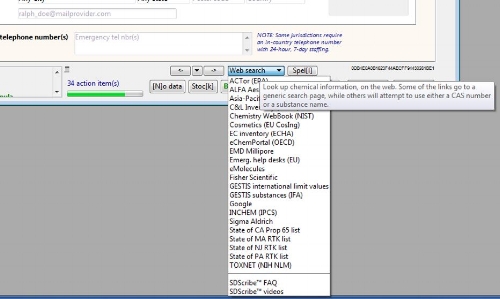(Originally posted Jul 20, 2017. Revised Dec 18, 2017. Minor reformatting on Mar 24, 2020. Updated selected links on Aug 30, 2021)
Governmental chemical, safety and environmental resources
Some governmental agencies maintain online resources which are useful when creating safety data sheets.
NOTE: Changes to the locations of these references over the course of time may break the links. If a link is no longer valid, you may be able to locate the resource by searching the web.
National Library of Medicine (NLM, part of the National Institutes of Health, USA)
Decision guide – Helps in identifying the most appropriate resources related to toxicology, environmental effects, and other properties of hazardous materials. The guide also links to tutorials on the basic principles of toxicology.
CCRIS database (Chemical Carcinogenesis Research Information System) – Carcinogenicity, mutagenicity, tumor promotion, and tumor inhibition test results.
DART® (Developmental and Reproductive Toxicology) – Literature references for developmental and reproductive toxicity.
HSDB (Hazardous Substance Data Bank) – Human exposure, industrial hygiene, emergency handling, environmental, and regulatory information.
TOXLINE® – Biochemistry, pharmacology, and health effects of drugs and other chemicals.
TOXNET – Searches among several databases simultaneously for particular chemicals or topics.
Environmental Protection Agency (EPA, USA)
EnviChem (Finland) – Toxicology to aquatic organisms and other species. Persistence and accumulation in the environment. (2021-08-30 — This item does not appear to be available any longer at its original location.)
GESTIS Substance database (Germany) – Identification, physical and chemical properties, toxicology, ecotoxicology, safety, and regulatory information on approximately 8700 substances. The regulatory information includes GHS classifications appropriate for the EU/European Economic Area countries.
C&L Inventory (Classification and Labelling Inventory, European Chemicals Agency) – GHS classifications for substances. Manufacturers and importers provide the data as part of the EU/EEA notification and registration process. ECHA does not verify the accuracy of the data. Also includes classification information derived from the European regulations (Tables 3.1 and 3.2 of Annex VI of EU 1272/2008).
Classifying a product
The first step in creating a safety data sheet is to identify each ingredient, its CAS number, and concentration in the product. The resources listed above can then assist in determining hazard classification(s) for the ingredients.
Some countries or groups of countries have modified the GHS criteria so that an ingredient may be classified more stringently than the GHS standard itself. Another potential issue is that countries may have implemented a subset of the total list of GHS classifications, so that a classification in one country may not be applicable in another country. Some regulatory agencies also maintain substance lists; if an ingredient appears on the list, then you must use the prescribed classification(s).
Because of these potential variations, ensure that you consult the regulations for the country into which you are supplying the product. (The GESTIS Substance database is particularly useful if you are shipping products into non-US markets.)
When determining health-related hazard classifications for the product as a whole, it may be possible to apply GHS formulas and/or table values to the individual ingredients. As with ingredient classification, however, the mixture criteria may vary somewhat from country to country.
When determining physical hazard classifications (e.g., flammability or water reactivity) for the product as a whole, it may be necessary to conduct laboratory testing. Even if the physical hazards for individual ingredients are known, these hazards may not apply to the product as a whole.
Below are links to US-OSHA hazard classification criteria. Their derivation is largely from the GHS standard.
Use of an SDS authoring program
SDS authoring software can maintain useful chemical, physical, health and environmental data for your product and its ingredients. It may also assist in classifying a mixture by applying formulas and table values.
The following videos illustrate the use of an SDS authoring program (SDScribe™) for classifying a substance, and for using a built-in algorithm to suggest health hazards of a mixture.
You can access useful resources within SDScribe™ (like those listed above) by clicking on the "Research" drop down menu. Let us know if there are other useful resources you think we should add to the menu.
Select a web location from the drop-down list



